Racial policy of Nazi Germany

| Part of a series on |
| Nazism |
|---|
The racial policy of Nazi Germany was a set of policies and laws implemented in
Nazi policies labeled centuries-long residents in German territory who were not ethnic Germans such as Jews (understood in Nazi racial theory as a Semitic people of Levantine origins), Romani (an Indo-Aryan people originating from the Indian subcontinent, historically colloquially referred to derogatorily as "Gypsies"), along with the vast majority of Slavs (mainly ethnic Poles, Serbs, Ukrainians, Russians, Belarusians, etc.), and most non-Europeans as inferior non-Aryan subhumans (under the Nazi appropriation of the term "Aryan") in a racial hierarchy that placed the Herrenvolk ("master race") of the Volksgemeinschaft ("people's community") at the top.[1][2][3][4]
The racial policy of the
Historical origins of Nazi racial theories and policies
Influences and inspirations from American racism
Nazi racial policies were in many ways directly influenced by the United States. The Nazis used "American Models" of racism to oppress and subjugate racial minorities as referenced by James Q. Whitman, author of Hitler's American Model and Professor at Yale University, who stated in his book "In the 1930s, Nazi Germany and the American South had the appearance, in the words of two southern historians, of a "mirror image": these were two unapologetically racist regimes, unmatched in their pitilessness."[10] Jim Crow Era laws were a key inspiration for Adolf Hitler and the Nazi party, as the Nazis mirrored their form of racial oppression and segregation in the model of Jim Crow and segregation policy of the United States. However, the treatment of Native Americans was also an inspiration for Nazi ideology, similar to Jewish people; Native Americans had been integral to America.[11] They had been settled for thousands of years in the Americas (obviously, Germany as an entity has existed since 1871, but Jewish settlement in the lands of Central Europe has dated back over one thousand years at the very least.)[12] Nevertheless, the model of oppression and subjugation for both groups directly modeled what the Nazis implemented to oppress racial minorities that did not make up the Aryan composite. Banning from civil service, segregation, barring marriage between Aryans and non-Aryans, as well as the expulsion of Jewish people and other "undesirables" from government, military, and other essential positions,[13] were the most essential aspects of the Nuremberg Laws of 1935 and were directly modeled by what had been done to Black Americans during Jim Crow.[10] Arguably, the most influential of American policies can be seen in "Lebensraum," or an expansion of land exclusively for German Aryans, which saw the expulsion, murder, and enslavement of Jewish people, Slavic peoples, and other races deemed inferior. Manifest Destiny would directly influence this policy of forced removal and, in many ways, as the destruction of Native American livelihoods paved the way for Anglo American expansion and prosperity, so would the destruction of Slavic and Jewish livelihoods for the sake of Aryan expansion and prosperity.[14]
Basis of Nazi policies and the constitution of the Aryan Master Race
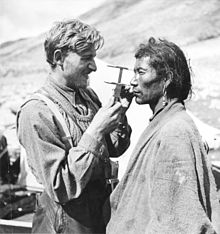
The Aryan master race conceived by Adolf Hitler and the other Nazis graded humans on a scale of pure Aryans to non-Aryans (who were viewed as subhumans).[15] At the top of the scale of pure Aryans were Nordic-type Germans and other Nordic-Aryan Germanic and Northern European peoples, including the Dutch, Scandinavians, and the English.[15] Latins were held to be somewhat inferior, but were tolerated; and the French were thought to have a suitable admixture of Germanic blood.[16]
The feeling that Germans were the Aryan
We are a master race, which must remember that the lowliest German worker is racially and biologically a thousand times more valuable than the population here.
— Erich Koch, 5 March 1943[17]
The Nazis considered the
Nazi racial beliefs of the superiority of an Aryan master race arose from earlier proponents of a supremacist conception of race such as the French novelist and diplomat
Racist author and Nordic supremacist[33] Hans F. K. Günther, who influenced Nazi ideology, wrote in his "Race Lore of German People" (Rassenkunde des deutschen Volkes) about the danger of "Slavic blood of Eastern race" mixing with the German[34] and combined virulent nationalism with Antisemitism.[35] Günther became an epitome of corrupt and politicized pseudo-science in post-war Germany.[36] Among the topics of his research were attempts to prove that Jews had an unpleasant "hereditary smell".[37] While one of the most prominent Nazi writers, Günther still was not considered the most "cutting edge" by Nazis.[38]
The July 1933
The Nazi Party wanted to increase birthrates of those who were classified as racially elite. When the Party gained power in 1933, one of their first actions was to pass the Law for the Encouragement of Marriage. This law stated that all newly married couples of the Aryan race could receive a government loan. This loan was not simply paid back, rather a portion of it would be forgiven after the birth of each child. The purpose of this law was very clear and simple: to encourage newlyweds to have as many children as they could, so that the Aryan population would grow.[40]
Racial policies regarding the Jews, 1933–1939
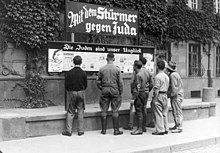
Approximately 525,000
On April 1, 1933, the Nazi boycott of Jewish businesses was observed throughout Germany. Only six days later, the Law for the Restoration of the Professional Civil Service was passed, banning Jews from government jobs. It is notable that the proponents of this law, and the several thousand more that were to follow, most frequently explained them as necessary to prevent the infiltration of damaging, "alien-type" (Artfremd) hereditary traits into the German national or racial community (Volksgemeinschaft).[48] These laws meant that Jews were now indirectly and directly dissuaded or banned from privileged and superior positions reserved for "Aryan Germans". From then on, Jews were forced to work in more menial positions, becoming second-class citizens or to the point that they were "illegally residing" in Nazi Germany.
In the early years of Nazi rule, there were efforts to secure the elimination of Jews by expulsion; later, a more explicit commitment was made to extermination. On August 25, 1933, the Nazis signed the
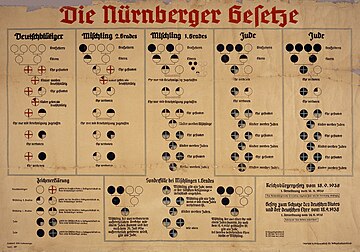
Nuremberg Laws
This section needs additional citations for verification. (April 2021) |
Between 1935 and 1936, persecution of the Jews increased apace while the process of "
The drafting of the Nuremberg Laws has often been attributed to Hans Globke. Globke co-authored several aspects of the laws, such as the ordinance which legally required Jews with non-Jewish names to take on the additional first names Israel or Sara, along with the official legal commentary on the Reich Citizenship Law.[52]
In 1936, Jews were banned from all professional jobs, effectively preventing them from having any influence in education, politics, higher education, and industry. There was now nothing to stop the anti-Jewish actions that spread across the German economy.
Between 1937 and 1938, new laws were implemented, and the segregation of Jews from the "German Aryan" population was completed. In particular, Jews were punished financially for being Jewish.
From March 1, 1938, government contracts could not be awarded to Jewish businesses. On September 30, "Aryan" doctors could only treat "Aryan" patients. Provision of medical care to Jews was already hampered because Jews were banned from being doctors.
On August 17, Jews with first names of non-Jewish origin were legally required to add "Israel" (males) or "Sara" (females) to their names, and a large letter "J" was to be printed on their passports on October 5.[52] On November 15, Jewish children were banned from going to state-run schools. By April 1939, nearly all Jewish companies had either collapsed under financial pressure and declining profits, or been persuaded to sell out to the government, further reducing their rights as human beings; they were, in many ways, effectively separated from the German populace.
The increasingly
Jewish responses to the Nuremberg Laws
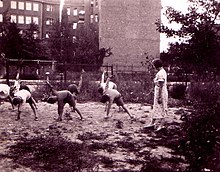
After the promulgation of the Nuremberg Laws, the Reichsvertretung der Deutschen Juden (Representation of the German Jews) announced the following:
The Laws decided upon by the Reichstag in Nuremberg have come as the heaviest of blows for the
Jews in Germany. But they must create a basis on which a tolerable relationship becomes possible between the German and the Jewish people. The "Reichsvertretung der Deutschen Juden" is willing to contribute to this end with all its powers. A precondition for such a tolerable relationship is the hope that the Jews and Jewish communities of Germany will be enabled to keep a moral and economic means of existence by the halting of defamation and boycott.The organization of the life of the Jews in Germany requires governmental recognition of an autonomous Jewish leadership. The Reichsvertretung der Juden in Deutschland is the agency competent to undertake this.
The most urgent tasks for the "Reichsvertretung", which it will press energetically and with full commitment, following the avenues it has previously taken, are:
Our own Jewish educational system must serve to prepare the youth to be upright Jews, secure in their faith, who will draw the strength to face the onerous demands which life will make on them from conscious solidarity with the Jewish community, from work for the Jewish present and faith in the Jewish future. In addition to transmitting knowledge, the Jewish schools must also serve in the systematic preparation for future occupations. With regard to preparation for emigration, particularly to
Hebrew language. The education and vocational training of girls must be directed to preparing them to carry out their responsibilities as upholders of the family and mothers of the next generation.[53]
Sinti and Roma
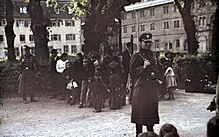
Nazi Germany began persecution of the Romani as early as 1936 when they began to transfer the people to municipal internment camps on the outskirts of cities, a prelude to the deportation of 23,000 Gypsies to concentration camps. "Pure-blooded" Gypsies were considered by the Nazis to be Aryan.[54] Roughly ten percent of Gypsies were considered to be racially pure.[55]
Heinrich Himmler suggested creating a "Gypsy Law" to separate Gypsies from the German people:
The aim of measures taken by the State to defend the homogeneity of the German nation must be the physical separation of Gypsydom from the German nation, the prevention of miscegenation, and finally, the regulation of the way of life of pure and part-Gypsies. The necessary legal foundation can only be created through a Gypsy Law, which prevents further intermingling of blood, and which regulates all the most pressing questions which go together with the existences of Gypsies in the living space of the German nation.[56]
However, although many laws during Nazi Germany persecuted the Gypsies, a specific "Gypsy Law", although talked about often, was never enacted by the Nazis.[57]
Afro-Germans

In Mein Kampf, Hitler described children resulting from marriages to African occupation soldiers as a contamination of the Aryan race "by Negro blood on the Rhine in the heart of Europe."[58] He thought that "Jews were responsible for bringing Negroes into the Rhineland, with the ultimate idea of bastardizing the white race which they hate and thus lowering its cultural and political level so that the Jew might dominate."[59] He also implied that this was a plot on the part of the French, saying the population of France was being increasingly "negrified".[60][61]

The number of black people in Germany when the Nazis came to power is variously estimated at 5,000 to 25,000.[60][62] According to the United States Holocaust Memorial Museum, Washington, D.C., "The fate of black people from 1933 to 1945 in Nazi Germany and in German-occupied territories ranged from isolation to persecution, sterilization, medical experimentation, incarceration, brutality, and murder. However, there was no systematic program for their elimination as there was for Jews and other groups."[60]
Prior to Hitler coming to power, black entertainers were popular in Germany, but the Nazis banned
Of particular concern to the Nazi scientist
According to Susan Samples, the Nazis went to great lengths to conceal their sterilization and abortion program in the Rhineland.[63] Hans Massaquoi describes his experience as a half-African in Hamburg, unaware of the Rhineland sterilizations until long after the war.[64] Samples also points to the paradoxical fact that African-Germans actually had a better chance of surviving the war than the average German. They were excluded from military activity because of their non-Aryan status, but were not considered a threat and so were unlikely to be incarcerated. Samples and Massaquoi also note that African-Germans were not subjected to the segregation they would have experienced in the United States, nor excluded from facilities such as expensive hotels. However, they both state that downed black American pilots were more likely to become victims of violence and murder from German citizens than white pilots.[60]
Policies regarding Poles, Russians, and other Slavs
As early as 1925, Hitler suggested in Mein Kampf that the German people needed Lebensraum ("living space") to achieve German expansion eastwards (Drang nach Osten) at the expense of the "inferior Slavs". Hitler believed that "the organization of a Russian state formation was not the result of the political abilities of the Slavs in Russia, but only a wonderful example of the state-forming efficacity of the German element in an inferior race."[65]
After the invasion of the Soviet Union, Hitler expressed his future plans for the Slavs:
As for the ridiculous hundred million Slavs, we will mould the best of them as we see fit, and we will isolate the rest of them in their own pig-styes; and anyone who talks about cherishing the local inhabitants and civilising them, goes straight off into a concentration camp![66]
Nazi ideology viewed the Slavic peoples as non-Aryan
The final version of Generalplan Ost, essentially a grand plan for ethnic cleansing, was divided into two parts: the Kleine Planung ("Small Plan"), which covered actions which were to be taken during the war, and the Grosse Planung ("Big Plan"), which covered actions to be undertaken after the war was won (to be carried into effect gradually over a period of 25–30 years). The Small Plan was to be put into practice as the Germans conquered the areas to the east of their pre-war borders. The individual stages of this plan would then be worked out in greater detail. In this way, the plan for Poland was drawn up at the end of November 1939.
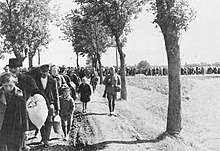
The plan envisaged removal of the majority of the population of conquered counties, with very small and varied percentages of the various conquered nations undergoing Germanisation, expulsion into the depths of Russia, and other fates, the net effect of which would be to ensure that the conquered territories would be Germanized.[18] Himmler declared during the Germanization process that no drop of German blood would be lost or left behind to mingle with any "alien races".[70] The Wehrbauer ("soldier-peasants") would settle in a fortified line to prevent civilization arising beyond and threatening Germany.[71]
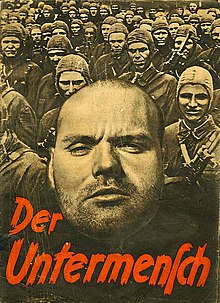
The Nazis issued the Polish decrees on 8 March 1940 which regulated the working and living conditions of Polish laborers (Zivilarbeiter) used during World War II in Germany. The decrees set out that any Pole "who has sexual relations with a German man or woman, or approaches them in any other improper manner, will be punished by death."[74] The Gestapo were extremely vigilant about sexual relations between Germans and Poles and pursued any case relentlessly where this was suspected.[75] There were similar regulations used against the other ethnic groups brought in from Eastern Europe, including the death penalty for sexual relations with a German person.[75] During the war, hundreds of Polish and Russian men were executed for their relations with German women.[76][77]
Heinrich Himmler, in his secret memorandum "Reflections on the Treatment of Peoples of Alien Races in the East" dated 25 May 1940, expressed his own thoughts and the future plans for the populations in the East.[78] Himmler stated that it was in the German interest to discover as many ethnic groups in the East and splinter them as much as possible, find and select racially valuable children to be sent to Germany to assimilate them and restrict non-Germans in the General Government and conquered territories to four-grade elementary school which would only teach them how to write their own name, to count up to 500 and to obey Germans.[78] Himmler believed the Germanization process in Eastern Europe would be complete when "in the East dwell only men with truly German, Germanic blood".[79]
After the launch of
Other "non-Aryans"
Though the laws primarily targeted Jews,
Iranians
Beginning in 1933, Nazi leadership made efforts to increase their influence in Iran, and they financed and managed a racist journal,
Nazi ideology was most common among Persian officials, elites, and intellectuals, but "even some members of non-Persian groups were eager to identify themselves with the Nazis"[attribution needed] and a supposed Aryan race.[85] In 1934, the Nazis celebrated the Ferdowsi millennial celebration in Berlin, in which the Nazi government declared that the German and Persian people share membership in a common Indo-Germanic race. Hitler declared Iran to be an "Aryan country"; the changing of Persia's international name to Iran in 1935 was done by the Shah at the suggestion of the German ambassador to Iran as an act of "Aryan solidarity".[86] Also, Hitler personally promised that if he defeated the Soviet Union, he would return all of the Persian land taken by Russians during the Russo-Persian Wars. Even in 1939, Germany provided Iran with the so-called German Scientific Library. The library contained over 7,500 books selected "to convince Iranian readers... of the kinship between the National Socialist Reich and the Aryan culture of Iran".[87]
In 1936, the
Turks and Turkics
Turks
In 1935, a half-Turkish half-German man named "Johannes Ruppert" was forced to leave the
In May 1942, a writer in the official journal of the Nazi Office for Racial Policy, Neues Volk, replied to a father's question caused by his daughter's relationship with a Turkish man, about whether racial differences between Germans and Turks meant that a marriage should not take place.[90][96] The reply read:[90]
A marriage or similar connection between your daughter with a Turk is out of the question. A Near Eastern blood element [Bluteinschlag] predominates among the Turks, among whom, alongside Oriental and Western racial components, mongoloid racial elements also enter. The Near Eastern and Oriental races are alien [artfremde] races. The same is true of the mongoloid [Mongolide] races. Moreover, in such cases, even when such racial considerations are not present, marriages of German young women with foreigners are not desirable. If your daughter does not want to listen to you, she faces the danger of being placed in protective custody. We emphatically point out to you and to your daughter the serious consequences of this behavior, one that obviously does not possess the slightest feeling for the honor of the Volk [nicht das geringste völkische Ehregefühl besitzt].[97]
Although the Nazi leadership agreed with the content of the reply, they criticized the journal for publishing it, because, in a foreign policy point of view, it was really clumsy ("denkbar ungeschickt") to publish before defeating the British in Middle East.[90][96] For example, Franz von Papen, the German ambassador to Turkey, informed the German Foreign Ministry that the publication of this text "has serious foreign policy considerations". He noted that such statements could aid "our Anglo-Saxon opponents" in their "propaganda against us" and asked the Office of Racial Politics not to publish such things in the future.[90] On May 16, 1942, Franz Rademacher, director of the Office of Jewish Affairs in the German Foreign Ministry, wrote to Walter Gross, the founder and editor of the magazine, that he "had no objection to the content of the information from a racial-political viewpoint but that it was "from a foreign policy standpoint, really clumsy” and "a political blunder" that would have "embarrassing and awkward foreign policy implications".[90] Nazi officials sought to prevent miscegenation between Turks and Germans and, if necessary, sought to imprison or deport the "offending" Turkish man.[90]
Crimean Karaites
The Crimean Karaites, Turkic speakers following Karaite Judaism, managed to get a declaration from the Reich Agency for the Investigation of Families that they were not to be considered of Jewish religion and their racial classification should be done individually.[98] However, not every Nazi officer or soldier were aware of the official position and a small number Karaites were murdered by German troops in Russia, as if they were Jews. The majority of the Karaites fared much better than the Turkic-speaking Jews, the Krymchaks.[99]
Norwegians
In
Finno-Ugrics
The
In 1941 Nazi Germany established the
After their first conflict with the Russians, the Finns applied to me, proposing that their country should become a German protectorate. I don't regret having rejected this offer. As a matter of fact, the heroic attitude of this people, which has spent a hundred of the six hundred years of its history in fighting, deserves the greatest respect. It is infinitely better to have this people of heroes as allies than to incorporate it in the Germanic Reich—which, in any case, would not fail to provoke complications in the long run. The Finns cover one of our flanks, Turkey covers the other. That's an ideal solution for me as far as our political protective system is concerned.[107]
East Asians



In Mein Kampf, Hitler expressed his praise for the Japanese's acceptance of European civilization and his contempt for the Chinese:
The foundation of actual life is no longer the special Japanese culture, although it determines the color of life-because outwardly, in consequence of its inner difference, it is more conspicuous to the European-but the gigantic scientific-technical achievements of Europe and America; that is, of Aryan peoples. Only on the basis of these achievements can the Orient follow general human progress. They furnish the basis of the struggle for daily bread, create weapons and implements for it, and only the outward form is gradually adapted to Japanese character.[108]
What they mostly meant by Germanization was a process of forcing other people to speak the German language. But it is almost inconceivable how such a mistake could be made as to think that a Negro or a Chinaman will become a German because he has learned the German language and is willing to speak German for the future, and even to cast his vote for a German political party.[108]
Since 1926,
Due to Nazi Germany's recognition of Japanese as "
Although of a separate and different evolutionary race, the Imperial Japanese were considered by Nazi ideologists such as Himmler as having sufficiently superior qualities as did German-Nordic blood to warrant an alliance. Himmler, who possessed a great interest in, and was influenced by, the anthropology, philosophies and pantheistic religions of East Asia, mentioned how his friend Hiroshi Ōshima, the Japanese Ambassador to Germany, believed that the noble castes in Japan, the daimyo and the samurai, were descended from gods of celestial origin, which was similar to Himmler's own belief that "the Nordic race did not evolve, but came directly down from heaven to settle on the Atlantic continent."[119]
Initially, the Japanese were still subject to Germany's racial laws, which – with the exception of the 1935
Then in October 1933, German Foreign Minister Konstantin von Neurath issued an exemption to and Japanese from the racial laws. Additionally, in April 1935 another Nazi decree stated that racial discrimination cases involving Aryans of the East (aka. Japanese) that might jeopardize German diplomatic relations—i.e., Japanese—would be dealt with individually. Decisions on some cases sometimes took years, with those affected unable to obtain jobs or interracially marry, primarily because the German government preferred as much as possible to avoid giving exemptions. The German government often exempted more German-Japanese than it preferred in order to avoid a repeat of the 1933 controversies, and in 1934 it prohibited the German press from discussing the race laws when Japanese were involved to avoid any diplomatic problems with China or Japan.[120]
Germanization between 1939 and 1945
Nazi policy stressed the superiority of the Nordic race, a sub-race of the white European population defined by the measurement of the size and proportions of the human body models of racial difference.[121] From 1940 the Nazi authorities in the General Government (occupied Poland) divided the population into different groups.[70] Each group had different rights, food rations, allowed strips in the cities, separated residential areas, special schooling systems, public transportation and restricted restaurants. Later adapted in all Nazi-occupied countries by 1942, the Germanization program used the racial caste system of reserving certain rights to one group and barred privileges to another. Ethnic Poles were believed by Hitler to be "biologically inferior race" that could never be educated or elevated through Germanization.[122] In 1940, Hitler approved of a plan regarding the Germanization of the Protectorate of Bohemia and Moravia, he estimated around half of the Czech population were suitable for Germanization but made clear that the "mongoloid" types and Czech intelligentsia were not allowed to be Germanized.[123]
During the occupation of Poland, the Nazi government kidnapped children with Nordic racial characteristics. Those classified as "racially valuable" were sent from to the German Reich to be adopted and raised as Germans, while those who failed the tests would be used in slave labor or murdered in medical experiments.[124]
Nordicist anthropometrics was used to "improve" the racial make-up of the Germanized section of the population, by absorbing individuals into the German population who were deemed suitably Nordic.[18]
Germanization also affected the Sorbs, the minority Slav community living in Saxony and Brandenburg, whose Slavic culture and language was suppressed to absorb them into German identity.[125] Tens of thousands suffered internment and imprisonment as well, to become lesser-known victims of Nazi racial laws.[126] Similarly, the Nazis considered the people living in the Goralenvolk area to be descended from ethnic Germans and were therefore classified as Aryans.[127]
See also
- Ahnenerbe
- Anti-Jewish legislation in prewar Nazi Germany
- Anti-Romani sentiment
- Antisemitism
- Antisemitism in Europe
- Antisemitism in 21st century Germany
- Anti-Slavic sentiment
- Aryan certificate
- Aryan paragraph
- Aryanization
- Badge of shame
- Consequences of German Nazism
- Eugenics
- Greater Germanic Reich
- Honorary Aryan
- Kaiser Wilhelm Institute of Anthropology, Human Heredity, and Eugenics
- Kaiser Wilhelm Society
- Master race
- Josef Mengele
- Nationalsozialistischer Reichsbund für Leibesübungen
- Nazi eugenics
- Nazi racial theories
- Nordicism
- Office of Racial Policy
- Porajmos
- Racial hierarchy
- Racial discrimination
- Racial segregation
- Racism
- Racism in Europe
- Racism in Germany
- White nationalism
- White supremacy
- Yellow badge
- Renordification
References
- ^ Operation Barbarossa: Ideology and Ethics against Human Dignity, by André Mineau, (Rodopi, 2004) page 180
- ^ The Czechs under Nazi Rule: The Failure of National Resistance, 1939–1942, Vojtěch Mastný, Columbia University Press [page needed]
- ^ Hitler's Home Front: Wurttemberg Under the Nazis, Jill Stephenson p. 135, Other non-'Aryans' included Slavs, Blacks and Roma .
- ^ a b The Politics of Fertility in Twentieth-Century Berlin - Page 118 Annette F. Timm - 2010 The Nazis' singleminded desire to "purify" the German race through the elimination of non-Aryans (particularly Jews, Gypsies, and Slavs)
- ^ Ihrig, pages 90-135.
- German people (Volk) as a mystical, pseudobiological whole and the state as an "organism" in which the individual was subsumed in the whole ("You are nothing, your Volk is everything"); the condemnation of Jews as an alien force representing chaos, mechanism, and inauthenticity. Hitler himself had even used the stock imagery of conservative holism in Mein Kampfwhen he spoke of the democratic state as "a dead mechanism which only lays claim to existence for its own sake" and contrasted this with his vision of statehood for Germany in which "there must be formed a living organism with the exclusive aim of serving a higher idea."
- ^ anti-Semitism of young faculty and students was particularly virulent. Moreover, I show that scientists supported Nazi ideologies and policies not only through so-called reductionist science such as eugenics and race-hygiene, but also by promoting organicist and holistic ideologies of the racial state. [...] The ideology of leading Nazi party ideologues was strongly influenced by the Volkish movement which, in the wake of the writings of philosopher Johann Gottlieb Fichteand other nineteenth century authors, promoted the idea of Volk (people) as an organic unity. They did not base their virulent anti-Semitism and racism on anthropological concepts.
- Homo sapiens. A substantial part of this chapter will thus return to their research on human ecology to explore the mutual field of inspiration linking them and Smuts. Two aspects of this human ecological research were particularly important: the human gradualism or ecological "succession" of human personalities researched by Bews, and the concept of an ecological biotic community explored by Phillips. Smuts transformed this research into a policy of racial gradualism that respected local ways of life in different (biotic) communities, a policy he tried to morally sanctify and promote as author of the famous 1945 Preamble of the United Nation Charterabout human rights.
- Weimar Germany and then under Nazism, holistic science became a mainstream academic endeavour, once more intermingling cultural politics and serious scientific research. Holistic perspectives also became popular in the interwar years among academics and the wider public throughout the UK and US. In France, it was associated with vitalist philosophiesand the emergence of neo-Hippocratic thinking in medicine, manifesting the unease many people felt about the shifts that biomedicine was undergoing at the time.
- ^ ISBN 9780691183060.
- ^ Little, Becky (August 16, 2017). "How the Nazis Were Inspired by Jim Crow". History.com.
- ^ Baeck Institute, Leo (April 2021). "1,700 YEARS OF JEWISH LIFE IN GERMANY" (PDF).
- ^ Bradsher, Greg (2010). "The Nuremberg Laws". www.archives.gov.
- ^ "Lebensraum". encyclopedia.ushmm.org. Retrieved 2024-03-24.
- ^ a b Davies 2006, p. 167.
- ^ Davies 2006, p. 44.
- ^ Shirer 1960, p. 939.
- ^ ASIN B0006BXJZ6. Archived from the original(Paperback) on 9 April 2011. Retrieved 14 March 2014.
- ^ ISBN 978-1-4422-2270-0.
- ISBN 978-0-691-08684-2.
- ^ a b Davies 2006, pp. 167, 209.
- ^ a b Longerich 2010, p. 241.
- ^ a b Simone Gigliotti, Berel Lang. The Holocaust: A Reader. Malden, Massachusetts, USA; Oxford, England, UK; Carlton, Victoria, Australia: Blackwell Publishing, 2005. Pp. 14.
- ^ "Hitler's Home Front: Wurttemberg Under the Nazis" Jill Stephenson page 113 " Other non-'Aryans' included Slavs, Blacks and Roma and Sinti (Romanies)"
- ^ a b George Victor. Hitler: The Pathology of Evil. Washington, DC, USA: Potomac Books, Inc, 2007. Pp. 117.
- ^ Aly 2014, p. 154.
- ^ Evans, Richard J. (2003). The Coming of the Third Reich, p.33
- ^ The Cambridge Companion to Tacitus Page 294 A. J. Woodman - 2009 The white race was defined as beautiful, honourable and destined to rule; as 'cette illustre famille humaine, la plus noble'.74 Originally a linguistic term synonymous with Indo-European,7S 'Aryan' became, not least because of the Essai, the designation of a race, which Gobineau specified as 'la race germanique'
- ^ So that the reader not be left in ignorance as to who the Aryans are, Gobineau stated: "La race germanique était pourvue de toute l'énergie de la variété ariane." We see, then, that Gobineau presents a racist theory in which the Aryans, or Germans, are all that is good Comparative literature by American Comparative Literature Association.; Modern Language Association of America. Comparative Literature Section.; University of Oregon. 1967, page 342
- ^ Evans, Richard J. (2003). The Coming of the Third Reich. New York, p.33-34
- ^ Aly 2014, p. 157.
- ^ Kühl 2002, p. 85.
- ^ Kohn, Marek (1996). The Race Gallery: The Return of Racial Science. Vintage. p. 48.
- ISBN 9783643901255
- ISBN 9780815339434
- ^ Race, Color, Identity: Rethinking Discourses about "Jews" in the Twenty-first Century Efraim Sicher Berghahn Books, 15 May 2013
- ISBN 9780803220980
- ISBN 9780674022058
- ^ The law for the prevention of hereditarily diseased offspring. (Approved translation of the "Gesetz zur Verhütung erbkranken Nachwuchses"). Enacted on July 14, 1933. Published by Reichsausschuss für Volksgesundheitsdienst. (Berlin: Reichsdruckerei, 1935). (Official translation of the law into English)
- ^ Maynes, Mary Jo., and Ann Beth. Waltner (2012) "Powers of Life and Death": The Family: A World History Oxford: Oxford University Press. p.103
- ^ "Jewish Population of Europe in 1933: Population Data by Country". encyclopedia.ushmm.org.
- ^ Shirer 1960, p. 203.
- ^ Koonz 2003, p. 170.
- ^ Koonz 2003, p. 171.
- ^ Koonz 2003, p. 174.
- ^ Koonz 2003, p. 184.
- ^ Koonz 2003, p. 187.
- ^ Ehrenreich 2007, pp. 1, 165–167.
- ISBN 978-1-4766-7056-0.
- ISBN 9780691086842.
- ^ Burleigh & Wippermann 1991, p. 49.
- ^ ISBN 0-415-26038-8.
- ISBN 0195045238.
- ^ Lewy 2000, p. 139.
- ^ Lewy 2000, pp. 49, 137.
- ^ Burleigh & Wippermann 1991, p. 121.
- ^ Lewy 2000, p. 86.
- ^ Mein Kampf, volume 1, chapter XIII.
- ^ Mein Kampf, volume 1, chapter XI.
- ^ a b c d e f "The forgotten black victims of Nazi Germany". Voice Online. GV Media Group Ltd. 16 February 2009. Archived from the original on 23 February 2009. Retrieved 9 March 2014.
- ^ Adolf Hitler, Mein Kampf, Vol. II, chapter XIII
- ^ "Black people in Nazi Germany". Anne Frank Guide. Anne Frank House. 28 September 2018.
- ^ Samples, S., "African Germans in the Third Reich", The African German Experience, Carol Aisha Blackshire-Belay ed.
- ^ Massaquoi, Hans J., Destined to Witness: Growing Up Black in Nazi Germany, Harper Perennial, 2001. He mistakenly states that they were later murdered in the Holocaust, p.2
- ^ Adolf Hitler, Mein Kampf, 1925 [page needed]
- ISBN 978-1-936274-93-2.
- ^ Ehrenreich 2007, p. 10.
- ISBN 978-1-136-40156-5.
- ^ Longerich 2010, p. 83.
- ^ a b Overy 2004, p. 543.
- ISBN 0-396-06577-5
- ISBN 978-1-84545-501-9.)
{{cite book}}: CS1 maint: location (link) CS1 maint: multiple names: authors list (link - ^ "Der Untermensch". Digital Kenyon. Archived from the original on 26 November 2020.
- ISBN 978-0-19-160452-2.
- ^ ISBN 978-0-19-820297-4.
- ISBN 978-0-89604-712-9.
- ^ Diemut Majer, "Non-Germans" Under the Third Reich, p. 855
- ^ a b Himmler, Heinrich (25 May 1940). "Reflections on the Treatment of Peoples of Alien Races in the East". Trials of War Criminals Before the Nuernberg Military Tribunals Under Control Council Law No. 10. US Government Printing Office, District of Columbia. pp. 147–150, Vol. 13.
- ^ Mark Mazower, Hitler's Empire: How the Nazis Ruled Europe, p.181
- ISBN 978-1-84545-501-9.)
{{cite book}}: CS1 maint: location (link) CS1 maint: multiple names: authors list (link - ISBN 978-1-84545-501-9.)
{{cite book}}: CS1 maint: location (link) CS1 maint: multiple names: authors list (link - ^ "The Concept "Jew" in Nazi German "Race" Legislation". Archived from the original on 11 May 2008. Retrieved 21 June 2014.
- Hans F.K. Günther, The racial elements of European History, 1927
- ^ "Gypsies in the Holocaust".
- ^ a b c d Asgharzadeh 2007, pp. 91–94.
- ^ Hiro 1987, p. 296.
- ^ Lenczowski. 1944, p. 161
- ^ a b Herf 2011, pp. 18–24.
- ^ Ehrenreich 2007, pp. 9, 10.
- ^ JSTOR j.ctt1npq5k.
- ISBN 978-1-78533-785-7.
- ^ A 1378/36 (June 19, 1936), Political Archives of German Foreign Office. The circular: Ankara 539, doc. 82–35.B 8/4 (April 30, 1936), Political Archives of German Foreign Office.
- ^ a b c Motadel, David (2014) Iran and the Aryan myth. In: Ansari, Ali, (ed.) Perceptions of Iran: history, myths and nationalism from medieval Persia to the Islamic Republic. International library of Iranian studies (37). I.B. Tauris, London, UK, p. 134. ISBN 9781848858305
- ^ ISBN 978-0-674-74495-0.
- ISBN 978-0-674-36837-8.
- ^ a b Jeffrey Herf (2008). "Nazi Germany and the Arab and Muslim World: Old and New Scholarship" (PDF). Boston University. Retrieved 1 June 2023.
- ^ “Völkische Lebensfragen: Das Rassenpolitische Amt gibt Auskunft,” Neues Volk: Blatter des Rassenpolitisches Amt der NSDAP, vol. 10, no. 5, PAAA R99175, Inland Partei Akten, Umgang fremdrassiger Ausländer mit deutschen Mädchen,1941–43.
- ^ YIVO archives, Berlin Collection, Occ E, 3, Box 100, letter dated January 5, 1939.
- ^ "Somewhat Jewish, Fully Russian: Crimea Karaites Recall Past Glory". Haaretz. Retrieved 2 March 2022.
- ^ BBC, 4 February 2003, Norway's Nazi legacy (in English)
- ^ Le Figaro, 8 March 2007, Les enfants des nazis traînent la Norvège devant les tribunaux (Children of Nazis bring Norway before the Courts) (in French)
- S2CID 164636406.
- .
- ^ Kerola, Päivi (2018-04-22). "Sota vei Suoman natsien äitiyskotiin" (in Finnish). Yle. Retrieved 2022-08-01.
- ^ Historical dictionary of Estonia (2nd edition), by Toivo Miljan, Historical Dictionaries of Europe, Lanham, Rowman & Littlefield, 2015
- ^ Rich, Norman (1974). Hitler's War Aims: the Establishment of the New Order, pp. 400-401. W. W. Norton & Company Inc., New York.
- ^ Trevor-Roper, H.R. (2000). Hitler's Table Talk 1941–1944. New York: Enigma Books
- ^ a b Mein Kampf by Adolf Hitler, Volume One - A Reckoning, Chapter XI: Nation and Race http://fs2.american.edu/dfagel/www/HitlerMeinKampf.html
- ^ "Business: Kung's Credits" TIME Magazine
- ^ "That One Time the Nazis Helped China Fight Japan". 22 June 2017.
- ^ Yeung, Norton (28 September 2016). "An Unexpected Partnership in WW2: Nazi Germany and the Republic of China". Warhistoryonline.
- ^ "A Chinese in the German Wehrmacht | Shanghai 1937".
- ^ "How Did East Asians Become Yellow?".
- ^ a b "Hitler saw China and Japan as equals to Germany and even wrote admiringly: "I admit freely that their history is superior to our own"". 18 March 2017.
- ^ Adolf Hitler (1925). "The World War". Mein Kampf.
When the Russo-Japanese War came I was older and better able to judge for myself. For national reasons I then took the side of the Japanese in our discussions. I looked upon the defeat of the Russians as a blow to Austrian Slavism.
- ISBN 0-19-820626-7.
- ^ pp. 141, 158, 274, 290-291, 637-640, Ralph Manheim Translation, Mariner paperback edition
- ^ "Mein Kampf – Volume I, Chapter V". Archived from the original on 2013-11-21. Retrieved 2019-05-15.
- ^ The Activities of Dr. Ernst Schaefer, OI – Final Interrogation Report (OI-FIR) No. 32, Secret – United States Forces European Theater Military Intelligence Service Center APO 757, February 12, 1946, p. 4.
- ^ ISBN 1-85285-192-9.
- ^ Hutton 2005, pp. 9–10, 36–38, 101–105.
- ^ Weikart 2011, p. 73.
- ^ Weikart 2011, p. 67.
- ISBN 978-1-134-59693-5.
- ^ Hutton 2005, p. 159.
- ^ Burleigh & Wippermann 1991, pp. 131–135.
- ^ Wendt 2010, p. 85.
This section may require cleanup to meet Wikipedia's quality standards. The specific problem is: inconsistent citation style (e.g. page vs. p.); probably further copy-editing required. (February 2021) |
Bibliography
- ISBN 9780805097047.
- Asgharzadeh, Ailreza (2007). Iran and the Challenge of Diversity: Islamic Fundamentalism, Aryanist Racism, and Democratic Struggles. Palgrave Macmillan US. ISBN 978-1349538850.
- Black, Peter; Gutmann, Martin (2017) [2016]. "Racial theory and realities of conquest in the Occupied East: The Nazi leadership and non-German nationals in the SS and police". In Böhler, Jochen; Gerwarth, Robert (eds.). The Waffen-SS: A European History. S2CID 157309772.
- ISBN 978-0521398022.
- ISBN 978-0-333-69285-1.
- Ehrenreich, Eric (2007). The Nazi Ancestral Proof: Genealogy, Racial Science, and the Final Solution. Bloomington, Indiana: Indiana University Press. ISBN 978-0-253-34945-3.
- Herf, Jeffrey (2011). Nazi Propaganda for the Arab World: With a New Preface. Yale University Press. ISBN 978-0300168051.
- Hiro, Dilip (1987). Iran Under the Ayatollahs. Routledge & Kegan Paul Inc. ISBN 9780710211231.
- Hutton, Christopher (2005). Race and the Third Reich: Linguistics, Racial Anthropology and Genetics in the Dialectic of Volk. Cambridge and New York: Cambridge University Press. ISBN 978-0-74563-177-6.
- ISBN 0-674-01172-4.
- Kühl, Stefan (2002). The Nazi Connection: Eugenics, American Racism, and German National Socialism. Oxford University Press. ISBN 0-19-514978-5.
- Lewy, Guenter (2000). The Nazi Persecution of the Gypsies. Oxford University Press USA. ISBN 0195142403.
- Longerich, Peter (2010). Holocaust: The Nazi Persecution and Murder of the Jews. Oxford; New York: Oxford University Press. ISBN 978-0-19-280436-5.
- Overy, Richard (2004). The Dictators: Hitler's Germany, Stalin's Russia. W. W. Norton & Company. ISBN 0-393-02030-4.
- ISBN 978-0-671-62420-0.
- ISBN 978-0-230-11273-5.
- Wendt, Anton Weiss (2010). Eradicating Differences: The Treatment of Minorities in Nazi-dominated Europe. Cambridge Scholars Publishing. ISBN 978-1443823685.
Further reading
- ISBN 978-0-297-84278-1
- ISBN 0-531-09862-1.
- ISBN 0-8032-1327-1
- ISBN 0-06-019042-6
- König, Malte. Racism within the Axis: Sexual Intercourse and Marriage Plans between Italians and Germans, 1940–3, in: Journal of Contemporary History 54.3, 2019, pp. 508–526.
- ISBN 0-7134-5217-X.
- Proctor, Robert. Racial Hygiene: Medicine under the Nazis. Cambridge, MA: Harvard University Press, 1988. ISBN 0-674-74578-7
- Schafft, Gretchen E. From Racism to Genocide: Anthropology in the Third Reich. Urbana and Chicago: University of Illinois Press, 2004.ISBN 978-0-25207-453-0
- Weindling, Paul. Health, Race and German Politics between National Unification and Nazism, 1870–1945. Cambridge University Press, 1989. ISBN 0-521-42397-X
External links
- Nazi Racial Laws in English translation
- Nazi Racial Laws in the German original
- "Images of a 1938 German "J" Jewish passport from www.passportland.com". Archived from the original on 2011-04-02. Retrieved 2019-04-22.
